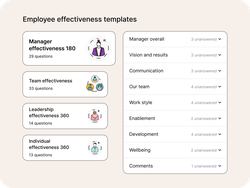
Article

Written by

Director of People Science, Product, Culture Amp
As more organizations embrace working in teams, we at Culture Amp set out to uncover how companies can best support and develop their teams. As Deloitte noted in their 2017 human capital trends report, companies are working to implement networks of empowered teams over structural hierarchies. This is because of the belief that designing work around teams will enable companies to stay ahead of the curve.
This rise in teamwork inspired us to create the Team Effectiveness survey. It was designed to provide teams with actionable insights for development. We've combined theory with academic and industry research to create the team effectiveness survey experience. What follows is a discussion of our research and why we chose to include some factors but not others.
Our research into Team Effectiveness started with a simple question: “How would we describe an effective team, and what are the factors that support this?”
Firstly, our definition of an effective team in today’s workplace is a team that's performing well and contributing to the company's overall success while simultaneously providing its members with an environment where they can do their best work, develop, and feel a sense of belonging and pride.
Secondly, we searched for the most important factors that enable effective teamwork. We studied contemporary academic literature and explored leading team models for insights into the characteristics and behaviors of high-performing teams.
Through this, we identified elements of team effectiveness that we all know and have come to expect – collaboration, clear communication, shared purpose, and operational efficiency. Outside of these traditional elements, we uncovered three behaviors that deserve more airtime in today’s world of team-oriented workplaces: psychological safety, dependability, and interpersonal sensitivity.
Organizational behavioral scientist Amy Edmondson of Harvard first introduced the construct of team psychological safety and defined it as “A shared belief held by team members that the team is safe for interpersonal risk-taking.”
In a nutshell, team psychological safety is when team members feel safe taking interpersonal risks. This construct was first introduced by organizational behavioral scientist Amy Edmondson in 1999, who positively correlated its relationship to team learning behavior. An important aspect is that team psychological safety is a shared belief amongst all members.
So how do you know if a team is strong on this construct? A core element is trust. Some behaviors you might see include team members speaking up and sharing their ideas (no matter how unpolished), admitting mistakes without fear of retribution, and openly discussing tough issues and misunderstandings.
Dependability is precisely what it sounds like – can team members rely on each other to do high-quality work? Dependability is also about helping each other when asked and offering to help without prompting. And, of course, dependability is marked by team members following through with commitments and doing what they say they will do. Dependability builds trust in a team which in turn creates greater psychological safety. In fact, all three of these factors overlap and enable the development of each other within the team.
Interpersonal sensitivity is centered on demonstrating understanding and empathy. When this is present, team members feel that their teammates genuinely care about each other’s well-being, and communication flows easily (even during conflict or disagreements). A subtle yet very important behavior is that team members take equal opportunities to speak during conversations. This behavior, known as conversational turn-taking, relies on team members paying close attention to what others are saying, inviting one another to participate, and not moving off-topic unless it’s cued as appropriate.
While they may not have the same labels, psychological safety, interpersonal sensitivity, and dependability appear in many well-known team models, including Richard Beckhard’s GRPI (interpersonal relationships), Lencioni's Five Dysfunctions of a Team (absence of trust and fear of conflict), and Google's Project Aristotle (psychological safety and dependability).
These factors have been shown to be some of the strongest predictors of team effectiveness. In fact, Google’s Project Aristotle identified psychological safety as the number one predictor of effective team performance. At Culture Amp, we use a diagnostic survey to help teams to provide inward feedback to understand where they sit concerning these factors.
Have teams reflect on these questions to understand how they’re going. If you’re looking to build a company that is equipped to thrive in the challenges of the future, investing in building team capability through team-focused feedback is an essential first step.
